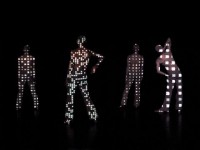KLAUS OBERMAIER, CHRIS HARING
Vivisector
source: exileat
To what extent does the quality of movement of the virtual world influence real sequences of human movement?
Will the real world of the 21st century assume via nanotechnology attributes of the virtual world?
Are there still significant differences between a body that is made of synthetic material and warmed artificially and the deep glow of trillions of living cells?
VIVISECTOR is an examination of the different speeds of people/nature and technology/information society and of their acceleration; an experiment to overcome the space-time continuum in the real world. It breaks the linearity of movement and in doing so shows the absurdity of momentum.
Based on the video-technological concept of the moving body-projection that made D.A.V.E. an international hit, VIVISECTOR now goes one step further: the exclusive concentration on video light and video projection produces a new stage aesthetic in which light, body, video and acoustic space form an unprecedented unity.
VIVISECTOR investigates and transcends physical boundaries by means of video-technological expansion, whereby it considers body language, dynamics, speed and physical presence from new choreographic aspects:
• Granulation and temporal reordering of movement sequences
• Simultaneously experiencing virtual and real situations
• Repeal of physical stasis
• Deconstruction of the body
• Interventions into organic structures via video technology
• Virtual suppleness as a distillate of physical permeability
At last reality only exists as a projection of light. We are distances of light. All technology is late sun-cult.
Paul Virilio
.
.
.
.
.
.
.
.
source: digicultit
La riflessione di Klaus Obermaier è significativamente partita da una puntualizzazione sul raggiunto valore culturale della tecnologia oggi, della ormai sopravvenuta “normalità” nella sua applicazione nel campo delle arti, ma sottolinea anche la necessità di un’integrazione narrativa di tutti i linguaggi scenici, ivi comprese proprio le nuove tecnologie: “Per me è assolutamente naturale l’uso delle tecnologie digitali nei miei progetti e nelle mie performance perché la componente tecnologica fa ormai parte della cultura di ogni giorno, non c’è nulla di straordinario in questo. Personalmente la uso semplicemente perché sono abituato a farlo, sono abituato a usare tecnologia per i miei lavori ormai da vent’anni e non mi domando più perché lo faccio. Come per la luce, nessuno si domanda più quale tipo di contributo possa dare alla narrazione teatrale, ma è evidente che sia così! Allo stesso modo per me la tecnologia è parte integrante della performance, a volte addirittura il punto di partenza e non soltanto un oggetto aggiunto”.
A questo punto Obermaier si sofferma a spiegare come la progettazione tecnologica debba svilupparsi in parallelo con il concept stesso e non materializzarsi durante l’ultima fase. Individuare la tecnologia preventivamente è fondamentale perché questa, come ogni altro elemento della composizione scenica, modifica l’assetto stesso della creazione. Il paragone proposto dall’artista è particolarmente pregnante: come è fondamentale individuare sin dall’inizio il costume per un performer, perché questo cambia radicalmente il suo modo di prepararsi, di recitare e di stare in scena, così deve essere per le tecnologie! Ma le logiche della produzione teatrale impongono troppo spesso delle gerarchie tra i materiali impiegati per l’allestimento e anche delle priorità: “I registi teatrali tradizionali lavorano prima di tutto su testi drammatici così per i primi mesi si danno da fare sul palco con il copione, la gente parla, cammina in scena, insomma quel genere di cose lì. Solo alla fine, ma proprio alla fine, aggiungono la tecnologia e giusto per essere adeguati ai tempi, ai nostri tempi. E’ un grosso problema perché bisognerebbe aggiungere la tecnologia sin dall’inizio: solo così questa cambierà completamente il significato dell’opera! Se tu la aggiungi tardi, cioè alla fine del processo creativo rimarrà una semplice appendice, non un elemento veramente sostanziale di un allestimento”.
.
.
.
.
.
.
.
.
source: 90146818
VIVISECTOR: A dance performance by Klaus Obermaier and Chris Haring
Der Tänzer ändert seine Hautfarbe, Körper vervielfältigen sich, lösen sich auf und mutieren zu negativer Materie. VIVISECTOR bricht die Linearität der Bewegung und zeigt damit die Absurdität des Moments.
Wie weit beeinflusst die Bewegungsqualität der virtuellen Welt reale menschliche Bewegungsabläufe? Wird die reale Welt im 21. Jahrhundert durch Nanotechnik Eigenschaften der virtuellen Welt annehmen? Gibt es noch nennenswerte Unterschiede zwischen einem Körper aus synthetischen Materialien mit künstlicher Wärme und der tiefen Glut von Billionen lebender Zellen?
VIVISECTOR erforscht und überwindet körperliche Grenzen durch videotechnische Erweiterung. Die Tanzperformance betrachtet Gestik, Dynamik, Geschwindigkeit und körperliche Präsenz unter neuen choreographischen Aspekten wie Auflösung/Granulation und zeitliche Neuordnung von Bewegungsabläufen, simultanes Erleben virtueller und realer Situationen, Aufhebung der körperlichen Statik, Infragestellung der individuellen Existenz durch virtuelle Verknüpfung genetischen Materials verschiedenen Ursprungs, Dekonstruktion des Körpers, videotechnische Eingriffe in organische Strukturen und virtuelle Geschmeidigkeit als Destillat körperlicher Durchlässigkeit.
Basierend auf der videotechnischen Grundidee der bewegten Körperprojektion des Welterfolges D.A.V.E. geht VIVISECTOR noch einen Schritt weiter: Die ausschließliche Konzentration auf Videolicht und Videoprojektion erzeugt eine neue Bühnenästhetik, in der Licht, Körper, Video und Klangraum eine bisher unerreichte Einheit bilden.
Choreografie, Tanz: Chris Haring
Visuelles Konzept, Video Art, Komposition: Klaus Obermaier
Tanz: Tom Hanslmaier, Chris Haring, Konstantin Mishin, Olaf Reinecke


